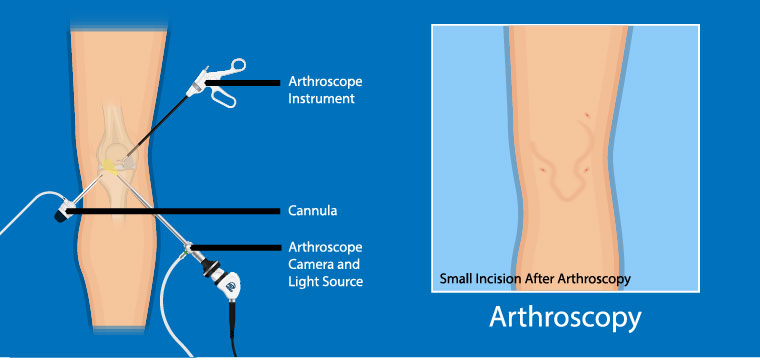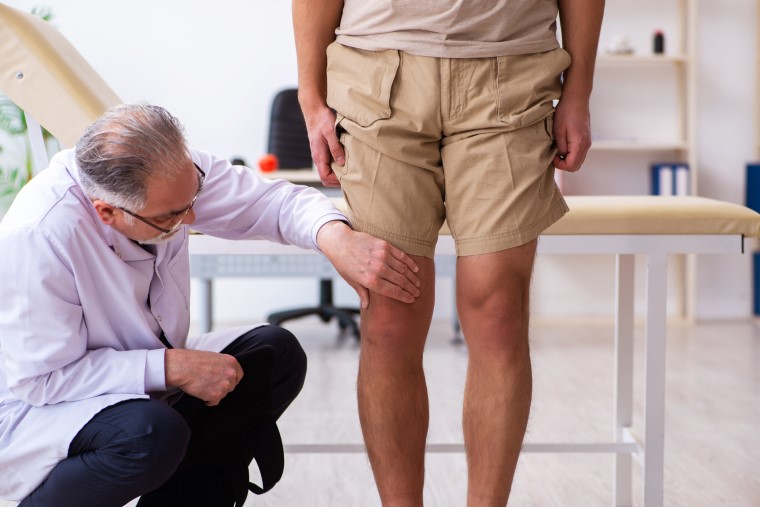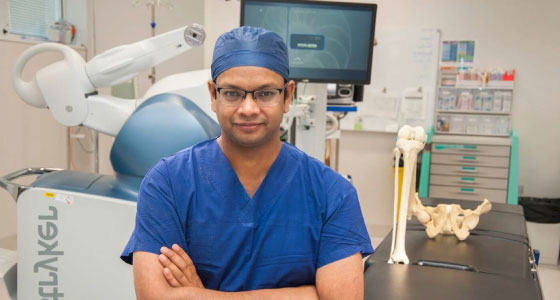The knee, also known as the tibiofemoral joint, is one of the largest and most complex joints in the body. It’s a hinge type synovial joint that is made up of the thigh bone (femur), shinbone (tibia) and the knee cap (patella). Due to its complexity, there are a number of conditions that can cause knee problems.
So if you’ve been suffering from knee pain and haven’t seen any improvement with physical therapy or anti-inflammatory medication, you may potentially require a knee arthroscopy to diagnose and treat certain knee conditions. Melbourne residents can contact the team at MOATI to find out how knee specialist Dr Chandrasekaran, can help both diagnose and treat their knee conditions.
What Is a Knee arthroscopy?
Knee arthroscopy is key-hole surgery of the knee joint that's used to diagnose and treat a number of conditions. During the minimally invasive surgical procedure, 2 to 4 small incisions are used to place a small camera and instruments inside the joint, to identify pain triggers and perform corrective procedures.

The procedure can be used to identify and treat issues like torn cartilage or a meniscal tear.
What conditions can be treated with knee arthroscopy?
There a many conditions that can be identified and treated with knee arthroscopy:
- Partial meniscectomy
- Repair of a torn meniscus
- Meniscus transplantation
- Anterior cruciate ligament or posterior cruciate ligament reconstruction
- Removal of inflamed synovial tissue
- Removal of loose bodies (cartilage or bone)
- Treatment of patella problems
- Treatment of knee sepsis
- Removal of a Baker’s cyst
- Fractures in the knee bones
- Swollen synovium (the lining in the joint)
Benefits of knee arthroscopy
There are a number of benefits to having this procedure over traditional knee surgery:
- Identify and treat conditions at the same time
- Low risk
- Minimally invasive
- Faster recovery
- Less tissue damage
- Fewer stitches
- Less pain after the procedure
- Lower risk of infection due to smaller incisions
- Smaller scars

What are the possible risks of knee arthroscopic surgery?
Any surgical or invasive procedure carries risks, but there are typically very few complications of knee arthroscopy. However, the possible unwanted effects are:
- Knee swelling
- Temporary discomfort
- Slight bruising
- Numbness around the knee
Serious complications such as deep vein thrombosis infection, bone fracture or permanent nerve injury inside the knee are extremely rare. Secondary procedures such as a knee replacement may be required in the future.
How is a knee arthroscopy performed?
Knee arthroscopy is usually performed under general anaesthetic, with between 2 and 4 incisions (approximately 5mm in length), made around the knee for the camera and surgical instruments to be inserted into the knee joint. The surgery usually takes between 45 minutes and 2 hours, depending on the complexity of the operation.
How to prepare for the surgery?
Dr Chandrasekaran, your orthopedic surgeon, will discuss your full medical history and note any allergies or illnesses you may have. He will then advise you in detail, on how you can prepare for the surgery and what you’ll need to do after.

How long does it take to recover from knee arthroscopy?
Your personal recovery will largely depend on the operation you’re having performed and full details will be discussed with you prior to the procedure. However, for a small procedure, the general post-operative recovery timeline is as follows:
Right after surgery
Straight after surgery, you’ll be taken to the recovery room for a couple of hours until the effects of the general anaesthetic have worn off. Most patients are able to return home after this.
Weeks 1 to 2
You’ll most likely be required to use crutches from the first week (but this may be up to 6 weeks). You may be able to drive a vehicle, as long as you’re not taking strong pain medication and can walk unaided. People with desk jobs can return to work.
Weeks 2 to 6
People in more heavy manual employment can usually return to work at this time. Physical therapy and exercises to keep your calf and thigh muscles active are essential. You may be able to introduce some low impact activities such as swimming and cycling.
After 6 weeks
Higher impact activities such as running may be possible to reintroduce at this stage.
Post-Operative and Physical therapy protocol
What is the cost of arthroscopic knee surgery in Melbourne?
The total cost for your surgery will depend on the specific procedure being performed and your health fund benefits. However, Dr Chandrasekaran’s team will provide you with a full breakdown of all potential costs and rebates.
We can also make all the necessary arrangements for you to have the procedure at either the Alfred Hospital or Werribee Mercy Hospital at no extra cost if you decide to have your surgery in the public system.
Why choose MOATI for a knee arthroscopy procedure?
We at MOATI understand how important knees are and how any pain or lack of mobility can seriously affect your everyday life. So we ensure we do everything in our power to help you, by devising the best treatment plan suited to your needs.

Dr Siva Chandrasekaran
Dr Siva Chandrasekaran is a highly trained Melbourne Orthopaedic Surgeon and specialist when it comes to knee arthroscopy. He’s completed prestigious fellowships in the United Kingdom, United States and Switzerland and published over 50 articles on hip and knee replacement and arthroscopy.
FAQs
If you still have any unanswered questions about knee joint arthroscopy, please don’t hesitate to contact us. Below are our most frequently asked questions about the procedure that may also provide the information you’re looking for.
If your knee joint is causing you significant pain and discomfort and you’ve not been able to alleviate it through non-surgical methods, this procedure is highly recommended.
Arthroscopy is considered a very advanced procedure and has a high success rate.
Most patients are able to leave the hospital approximately 2 hours after surgery but that depends on the individual and how well you recover from the general anaesthetic.
Whether you need crutches or a brace will depend on which type of treatment you’re having. Some patients are able to walk unaided after surgery but you will most likely have to use crutches for the first 1 to 2 weeks.
If you work in an office environment you should be able to return to work within 1 to 2 weeks. However, if you work in more heavy, manual employment, you may have to wait a few weeks longer until you’ve recovered more.
This also depends on the type of procedure you’ve had. Light, low impact activities can sometimes be reintroduced a few weeks after surgery. However, it usually takes at least 6 weeks to 3 months before higher impact activities and sports can be carried out again.
